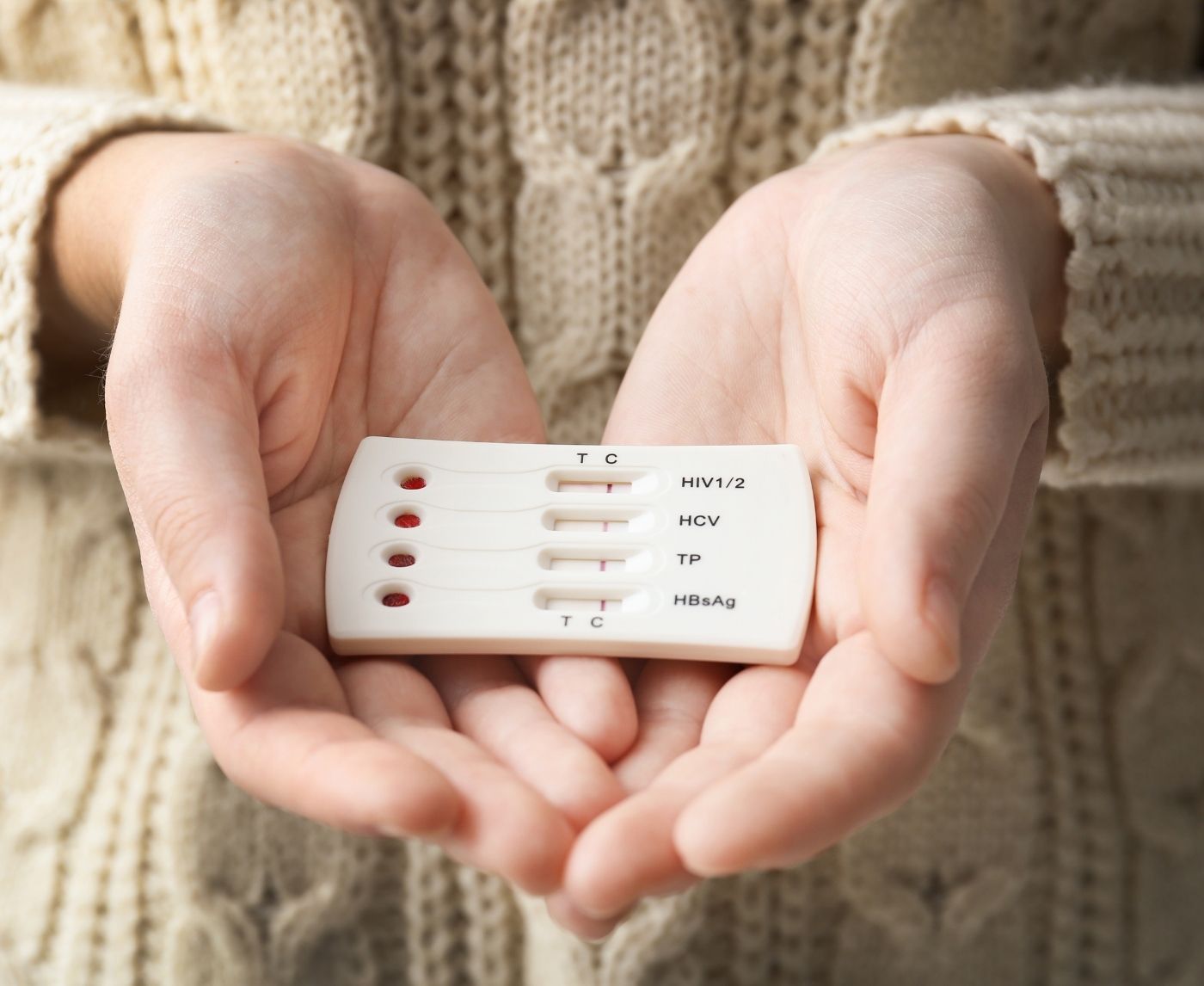How Accurate Is a Syphilis Rapid Test?
Quick Answer: Chlamydia in women can feel like mild cramping, vaginal pressure, abnormal discharge, or nothing at all. Many cases are symptomless, but untreated chlamydia can cause serious health issues like pelvic inflammatory disease (PID).
Why This Matters: Silent Symptoms, Real Consequences
For women, chlamydia doesn’t always show up with fireworks. In fact, the very nature of this infection is what makes it dangerous, it can sit quietly for weeks, even months, without symptoms. But left untreated, it can cause serious reproductive health complications, including infertility, ectopic pregnancy, and chronic pelvic pain.
That’s why understanding how chlamydia can feel, even when it doesn’t scream, is crucial. This guide is for you if:
- You’ve had unprotected sex and are wondering if that twinge means something.
- You’ve had a “clean” test before, but feel different now and don’t want to miss something.
- You’re in a relationship and worry about how to bring up testing without accusations.
- You just want to understand your own body better, without judgment, shame, or jargon.

People are also reading: Why Probiotics Won’t Protect You From Chlamydia
“It Was Just a Little Spotting, Until It Wasn’t”
Naomi, 27, first noticed something was off after a weekend with her long-distance boyfriend. She had spotting after sex, which she brushed off as roughness or stress. A week later, she felt a strange pressure in her pelvis, no real pain, just a nagging sensation. Her doctor initially suspected a UTI, but the test came back clean. It wasn’t until a friend mentioned STDs without symptoms that Naomi thought to ask for a full panel. The result? Chlamydia.
“I didn’t have pain or discharge or anything textbook. Just a feeling that something was off. I almost didn’t say anything at all.”
Her story is far from rare. Chlamydia often mimics or hides behind other common conditions, especially in cisgender women. The subtlety is what makes testing so important.
This Isn’t Just Razor Burn, And Here’s Why
Some early signs of chlamydia can be confused with yeast infections, period changes, or post-sex irritation. Here’s how some of the real symptoms might show up:
Table 1. Subtle chlamydia symptoms in women and why they’re commonly ignored or misattributed.
What If You Feel Nothing at All?
This is where chlamydia becomes especially tricky. It’s common, especially in women, for the infection to exist without any obvious signs. That doesn’t mean it’s harmless. In fact, asymptomatic chlamydia is often the most dangerous because it silently climbs the reproductive tract.
One study published in the journal Sexually Transmitted Diseases found that untreated chlamydia led to pelvic inflammatory disease in up to 30% of cases. That’s a serious, sometimes permanent condition affecting the uterus, fallopian tubes, and ovaries.
This is why routine screening matters, even if you feel fine, even if you trust your partner, even if you tested once a year ago. You can carry and spread chlamydia without knowing it.
Chlamydia or Something Else? How Women Misread the Signs
You're not imagining it, chlamydia often feels like something else entirely. Many women confuse it with a urinary tract infection (UTI), yeast infection, or bacterial vaginosis (BV). The overlap is real, but there are critical differences that matter when it comes to testing and treatment.
Let’s break it down through real-world scenarios, not textbook definitions. These are the subtle ways your body might signal something’s wrong, and how to tell the difference:
Table 2. Conditions commonly mistaken for chlamydia and how to tell them apart.
Still not sure? That’s okay. Testing is the only way to know for sure, and it doesn’t have to be a whole ordeal. You don’t need to visit a clinic to get clarity. You can order a discreet chlamydia test kit here and get results at home in minutes.
If your symptoms are confusing but persistent, like vague pelvic pressure, abnormal discharge, or pain after sex, it’s time to stop guessing and start testing. Catching an infection early is how you protect your body and your future.
Chlamydia Can Be Emotionally Invisible Too
It’s not just about physical symptoms. There’s an emotional layer here that’s often ignored. Some women describe “just feeling off”, not in their bodies, but in their moods. Increased anxiety, unexplained irritability, or hyper-awareness of their genital health.
Is it psychosomatic? Sometimes. But it’s also a reflection of how intuition shows up when the body’s trying to say something subtle. When you can’t shake the feeling that something’s wrong, even if your symptoms seem too minor to matter, that’s still valid. You don’t have to wait for full-blown pain to take action.
And if shame is what’s stopping you? Let’s drop it right now. You are not dirty. You are not “irresponsible.” You are informed and empowered. Testing is an act of care, not confession.

People are also reading: When to Test for Syphilis After Exposure (And When Not To)
Still Wondering If It's Worth Testing?
Here's the bottom line: if you've had unprotected sex or a new partner in the last 6 months and you're feeling off, even if your symptoms are vague, it's worth checking. Chlamydia is common, treatable, and often silent. Waiting doesn't make it go away. It just gives it more time to climb deeper into your reproductive tract.
Peace of mind is one test away. You don’t have to wonder. You don’t have to wait.
How to Get Tested: Rapid, Lab, or Clinic?
If you're wondering what kind of test to choose, you're not alone. Women who suspect chlamydia often delay testing simply because they don’t know where to start. Let’s break it down.
There are three main types of chlamydia testing:
Table 3. Comparing at-home and clinic options for chlamydia testing in women.
The NAAT (nucleic acid amplification test) is the same basic testing technology used in all three methods. It finds the DNA of chlamydia trachomatis. This is the most accurate method and is used a lot in both clinical and home settings.
The CDC's guidelines for STD testing say that NAAT can find chlamydia as soon as 7 days after exposure, but testing after 14 days gives the most accurate results. If you test too soon, you might get a false negative, especially if your body hasn't had enough time to build up bacteria to be able to find it.
“I Took a Test Too Soon and Thought I Was Fine”
Sofia, 31, tested herself five days after a one-night stand. The test was negative. She felt relieved, until two weeks later when she developed pelvic cramping that didn’t feel like her usual period. She took another test at day 17. This time, it came back positive.
“I didn’t know tests had a window. I trusted the first result, and almost ignored what my body was trying to say.”
She’s now in treatment and reaching out to her past partner. The second test helped her catch the infection before it caused long-term damage.
If you tested very early, consider a follow-up test after the 14-day mark, especially if your symptoms have changed, or you still feel unsure.
What If You Test Positive?
If you test positive for chlamydia, it's not the end of the world, but you should do something about it. The good news is? It's one of the easiest STDs to treat. The usual treatment is a 7-day course of doxycycline or a single-dose drug like azithromycin, depending on what your doctor says and your medical history.
Don't panic, don't ignore your partner, and don't start coming up with the worst possible scenarios for yourself. Antibiotics usually clear up most cases quickly, and chlamydia rarely causes long-term damage if caught early.
The most important thing is to follow through. Finish the full treatment, don't have sex for 7 days after that, and tell any partners you had sex with in the last 60 days so they can get tested too. A lot of people spread chlamydia without knowing it because they "feel fine." This is your chance to end that chain.
Should You Retest After Treatment?
Yes, especially if you're under 25, pregnant, or in a non-monogamous relationship. The CDC recommends retesting three months after treatment, even if you feel fine. This isn't because the antibiotics didn't work, it's because reinfection is common.
Retesting is a form of self-protection. It’s not about trust; it’s about truth. Life happens, bodies are vulnerable, and STDs don’t always announce themselves. Put a reminder in your phone. Do it for yourself.
Shipping, Privacy, and What It Feels Like to Wait
When you're anxious about symptoms or possible exposure, even waiting a day for results can feel unbearable. That’s why many women opt for at-home test kits, they’re private, fast, and discreet.
What to expect: Most rapid test kits arrive in plain packaging with no visible company or health references. You can test in your own bathroom, whenever you're ready. Results are yours alone to see, and no one is notified unless you choose to tell them.
Mail-in kits typically include a urine cup or vaginal swab. You follow simple instructions, send it back in a pre-labeled envelope, and check results online within a few days.
If you’re traveling, living rurally, or managing anxiety, at-home testing may be the best way to act without extra stress. And if you do test positive, treatment is fast and accessible, most clinics and telehealth services prescribe doxycycline as a first-line option.

People are also reading: Can You Still Have Sex If You Have Chlamydia?
FAQs
1. Can I really have chlamydia and feel totally fine?
Yes, and it happens a lot. Most women don’t get blazing red warning signs. You could have an active chlamydia infection and still feel like your usual self. That’s why it slips through the cracks. No weird discharge? No burning? Doesn’t mean you’re in the clear. Think of it like a leak behind a wall, just because you can’t see it, doesn’t mean it’s not there.
2. What does chlamydia feel like... if it does show up?
It might feel like mild cramping or pressure in your lower belly. Some people notice watery discharge, spotting after sex, or a dull ache that won’t go away. One woman described it as “that bloated, off-kilter feeling you get before your period, but it just stuck around.” It’s usually not dramatic. That’s part of what makes it so tricky.
3. Couldn’t it just be a UTI or something else?
Absolutely, it could be a UTI, BV, a yeast infection, or even ovulation. But here’s the catch: chlamydia can mimic all of those. If you’re guessing and not testing, you’re playing symptom roulette. If the symptoms don’t go away with standard treatments (like UTI meds or yeast creams), it’s time to consider an STD test.
4. What if I had unprotected sex last weekend, should I test now?
You can, but timing matters. Most chlamydia tests become reliable about 7–14 days after exposure. Testing before that might give you a false negative. If it’s been less than a week, consider waiting a few more days, or test now and plan a follow-up if needed. Peace of mind is worth it either way.
5. Will it go away on its own if I leave it alone?
Sorry, but no. Chlamydia doesn’t just pack up and leave. If you don’t treat it, it can spread to your uterus, fallopian tubes, and ovaries. That’s how pelvic inflammatory disease (PID) starts, and that can seriously affect your future fertility. Catch it early. Treat it early. Done.
6. Do I have to tell my partner?
You don’t have to do anything, but if they were exposed, they deserve to know. One simple way to say it: “Hey, I tested positive for chlamydia. You might want to get checked too.” No shame. No drama. Just facts. And if that conversation feels impossible, anonymous partner notification services exist and they work.
7. I took a test and it was negative. That means I’m good, right?
Maybe. Depends on when you took it. If it was less than 7 days after exposure, it might’ve been too early. If symptoms keep showing up, or your gut says something’s not right, take another test at the two-week mark. Trust your body. It knows things before your brain catches up.
8. Is discharge always part of it?
Nope. Some women have zero discharge. Others get light spotting, a watery trickle, or something they’d never describe as “STD-related.” If your discharge changes color, texture, or smell, and it’s not your normal ovulation pattern, it’s worth getting checked. Better to know.
9. Can I just order the medicine online and skip the test?
In some places, you technically can, but don’t. Taking antibiotics without knowing for sure can mask other infections, make things worse, or mess with your gut health for nothing. A fast test puts you in control. Treatment without clarity just adds confusion.
10. Is this a forever thing like herpes or HPV?
Nope. Chlamydia isn’t a lifelong infection. It’s treatable, curable, and often clears fast once you start meds. You just have to catch it. Think of it like a pothole, you don’t want to hit it over and over because you kept ignoring the signs.
How We Sourced This: This article was informed by approximately 15 reputable sources including peer-reviewed journals, CDC guidelines, and women’s health organizations.
Sources
1. Chlamydia — Symptoms in Women | NHS
2. Female Chlamydia Symptoms to Watch For | Healthline
3. Chlamydia: Symptoms, Causes, Treatment | WebMD
4. Chlamydia Infections in Women — MedlinePlus
5. What Are the Symptoms & Signs of Chlamydia | Planned Parenthood
6. Chlamydia: Symptoms, Causes & Prevention | EHG Health
Author: Dr. F. David, MD
Medical Reviewer: Dr. Jenna Ali, MPH
Last Reviewed: September 2025
Disclaimer: This article is for informational purposes only and is not a substitute for professional medical advice, diagnosis, or treatment. Always seek the guidance of a qualified healthcare provider with any questions you may have about a medical condition.







